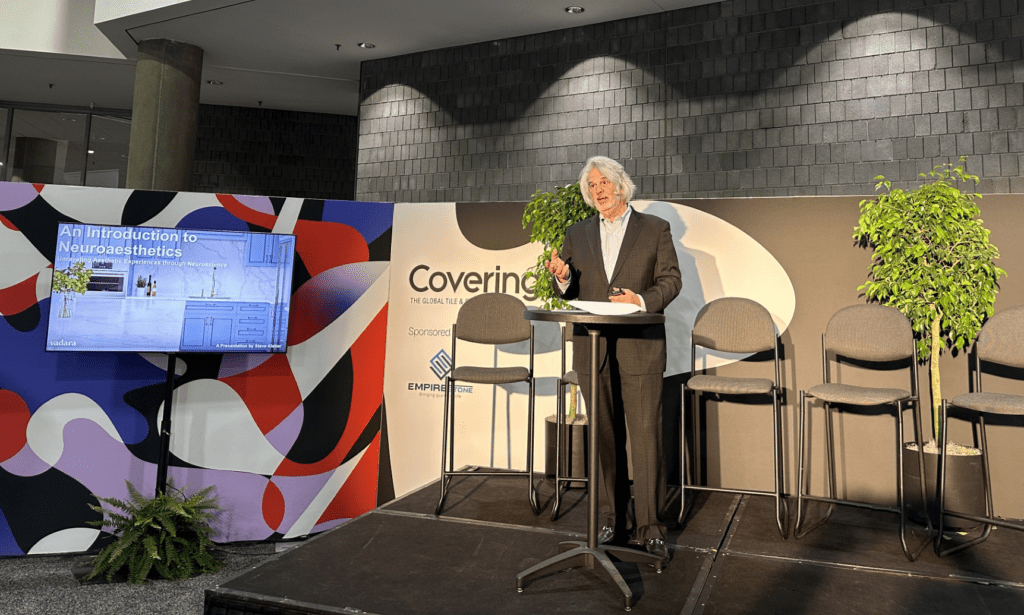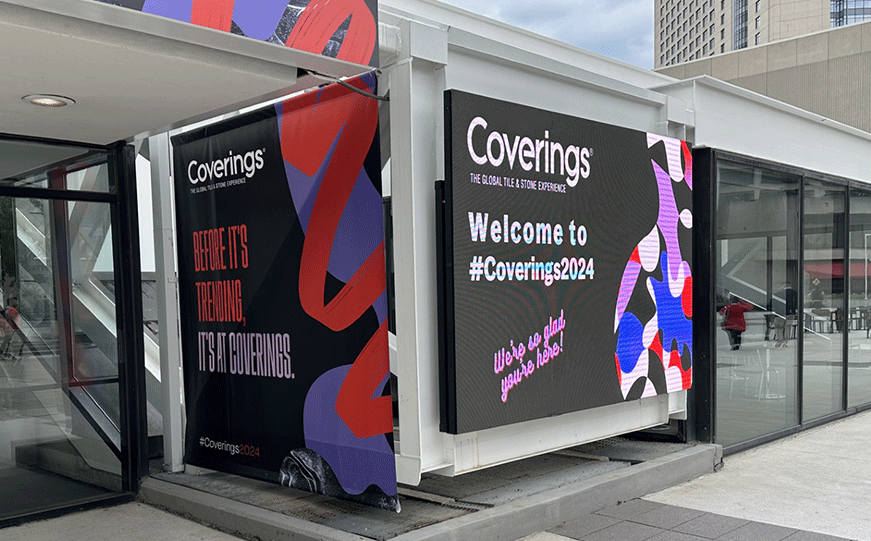Steve Kleber Featured at Coverings 2024 with a Presentation, “Neuroaesthetics: the Science of Beauty”
This week, Atlanta played host to the most prominent annual event highlighting the latest innovations, trends and technologies in the North American Tile and Stone industry — Coverings. As a marketing communications firm specializing in building products, our team is always excited to participate in this dynamic experience… which brings together some of the world’s most important architects, designers, trade professionals and industry influencers.
“Coverings 2024 was a successful show for our exhibitors and attendees alike. The Tile and Stone Industry is a dynamic and innovative force in North America, and it is always a pleasure to provide the forum where all of the vibrant energy takes center stage,” said Jenn Heinold, president of Taffy Event Strategies, the show management company for Coverings.
Coverings is much more than just a trade show… it’s a hub of creativity and collaboration that fuels the future of design and construction. Of course, there’s a vast array of specialized products and installation solutions — from stunning natural stone to quartz composites and large-format porcelain — as well as a vital forum for gaining valuable insights into the creation of some of the industry’s emerging trends.
For our team at Kleber and Associates, Coverings is a vital calendar milestone. It allows us to focus at the forefront of industry developments, forging meaningful connections with key stakeholders and showcasing our expertise in the building products sector. A large portion of our connection with Coverings this year was a presentation by agency founder, Steve Kleber at the show. His address connected the intriguing concept of Neuroaesthetics… into the dynamic world of design and architecture. Helping to guide the art and science of specifying color, texture and spatial arrangements to create environments — that not only please the eye but also resonate with innate human preferences — and emotional responses.

Exploring Neuroaesthetics
Have you ever wondered why a painting and the resonance of music can evoke such deep emotions? Or why certain architectural designs feel harmonious and calming? The field of Neuroaesthetics addresses these questions… offering insights into how brains perceive, process and respond to architecture and design. This interdisciplinary study bridges the gaps between neuroscience, psychology and the arts. Uncovering the universal, physical causes behind the creation of compelling aesthetic experiences.
Unveiling the Essence of Neuroaesthetics
Neuroaesthetics, at its core, aims to unravel the mysteries of human aesthetic appreciation… by studying the brain’s response. Looking beyond subjective preferences — to reveal actual neural mechanisms — that can be harnessed and nurtured.
The roots of this discipline stretch back to the mid-20th century when scientists first explored how the brain reacts to visual stimuli… initially in the context of art and beauty. Over time, this field has blossomed with the aid of advanced technologies like Magnetic Resonance Imaging (MRI), allowing researchers to observe brain activity in real-time.
The Neural Basis of Beauty
Neuroaesthetics challenges the notion that aesthetic experiences are purely subjective. Instead, the study recognizes that appreciation of beauty is deeply intertwined with sensory perception, emotions and cognitive processes.
Research in Neuroaesthetics explains that certain aesthetic preferences transcend cultural boundaries. In fact, evolutionary psychology offers compelling insights… suggesting that an appreciation for environmental landscapes (or even symmetrical designs) actually may be rooted in our forefathers’ survival instincts.
While some aspects of beauty are universal… others are influenced by cultural traditions. And societal norms.
Neuroaesthetics studies these cross-cultural variations — highlighting the dynamic nature of aesthetic sensibilities — and providing valuable guidance for designing products and living spaces that resonate with audiences.
Applying Neuroaesthetics in Design
Neuroaesthetics isn’t just an abstract concept… it has practical applications in architecture and interior design. Even in business and marketing.
By understanding how the brain responds to different stimuli, leaders can promote well-being and emotional connection through creative — yet predicable — solutions. Leveraging lighting, textures and color palettes designed to evoke specific desired emotional responses. And for enhancing the delivery of nurturing environments..
By decoding the brain processes involved in aesthetic experiences, creators can intentionally evoke specific emotions. And inspire audience reactions.
Future Directions
As technology continues to advance, Neuroaesthetics is poised to explore deeper layers of the neural tapestry. Advancements in artificial intelligence and even the study of the human genome promise to unveil much more detailed insights into individual responses to aesthetics. Paving the way for new discovery and innovation in art and design.
In Steve’s presentation, he created a vision and an invitation for the channel to explore profound connections between the brain and the world of aesthetics. By embracing this field of study, Steve asserted that it’s possible to gain a deeper — and more informed appreciation of beauty — enriching experiences within the built environment. As public awareness grows, so will the potential for impacting cultural shifts… toward a more profound understanding of the neural processes that shape our aesthetic world.
Neuroaesthetics opens doors to destinations where art, science and humanity converge. Communities where beauty is not merely observed. But instead, more deeply understood.
Trade shows like Coverings are important forums for building materials marketing and building material sales. If you’d like to review strategies and best practices for leveraging trade show experiences to enhance builder products brand marketing, we’re here to help. Send an email to Steve at sk@kleberandassociates.com to get the conversation started.




